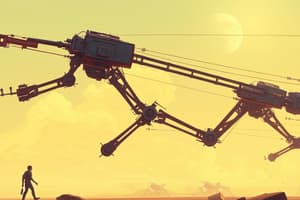Podcast
Questions and Answers
What is the primary characteristic of inverse kinematics in robotic motion?
What is the primary characteristic of inverse kinematics in robotic motion?
- It calculates the desired pose based on defined positions. (correct)
- It relies solely on prismatic joint configurations.
- It requires full pose definition for an articulated body.
- It eliminates all degrees of freedom for motion control.
In a hierarchical modeling data structure, what is a leaf node?
In a hierarchical modeling data structure, what is a leaf node?
- A node that provides fixed point rotations.
- A node that has no parent node.
- The highest node in the hierarchy.
- A node from which no arcs extend downward. (correct)
How many degrees of freedom does an unrestrained rigid body in space have?
How many degrees of freedom does an unrestrained rigid body in space have?
- Only one rotary motion around one axis.
- Six degrees of freedom, including both translating and rotary motions. (correct)
- Five degrees of freedom.
- Three translating motions.
Which of the following statements about joints in hierarchical modeling is true?
Which of the following statements about joints in hierarchical modeling is true?
What defines the minimum number of coordinates required to fully specify an object's motion?
What defines the minimum number of coordinates required to fully specify an object's motion?
What is the main focus of Chapter 5 in relation to motion?
What is the main focus of Chapter 5 in relation to motion?
Which term describes a sequence of objects where each object's motion can be described relative to the previous one?
Which term describes a sequence of objects where each object's motion can be described relative to the previous one?
What does Forward Kinematics require the animator to specify?
What does Forward Kinematics require the animator to specify?
In which scenario does Inverse Kinematics prove to be most beneficial?
In which scenario does Inverse Kinematics prove to be most beneficial?
What challenge does Forward Kinematics present with a high number of joints?
What challenge does Forward Kinematics present with a high number of joints?
What does the motion hierarchy often consist of?
What does the motion hierarchy often consist of?
Which branch of mechanics deals with the motions of objects without considering the forces involved?
Which branch of mechanics deals with the motions of objects without considering the forces involved?
What is a primary task when using Inverse Kinematics in animation?
What is a primary task when using Inverse Kinematics in animation?
Flashcards
Inverse Kinematics (IK)
Inverse Kinematics (IK)
A method in computer graphics where you specify a target position for a body part, and the software calculates the necessary joint angles to achieve that position.
Hierarchical Model (Data Structure)
Hierarchical Model (Data Structure)
A hierarchical data structure representing an articulated body, like a character or robot, using parent-child relationships between objects, with the root object at the top and leaf objects at the bottom.
Revolute Joint
Revolute Joint
A type of joint that allows one link to rotate about a fixed point on another link, like a hinge.
Prismatic Joint
Prismatic Joint
Signup and view all the flashcards
Degrees of Freedom (DOF)
Degrees of Freedom (DOF)
Signup and view all the flashcards
Relative Motion
Relative Motion
Signup and view all the flashcards
Motion Hierarchy
Motion Hierarchy
Signup and view all the flashcards
Kinematics
Kinematics
Signup and view all the flashcards
Forward Kinematics
Forward Kinematics
Signup and view all the flashcards
Inverse Kinematics
Inverse Kinematics
Signup and view all the flashcards
End Effector
End Effector
Signup and view all the flashcards
Solving for Joint Angles
Solving for Joint Angles
Signup and view all the flashcards
Articulated Body Animation
Articulated Body Animation
Signup and view all the flashcards
Study Notes
Computer Creative Art Lecture 7 (DM427)
- Lecture covers Kinematic Linkages
- Introduction to relative object motion
- Describing object motion is often easier related to another object like the sun in moon's motion.
- Relative motion sequences are found in astronomy, robotics, and human figure animation.
- This chapter focuses on animating objects whose motion is relative to another object, especially when there's a sequence where each object's movement is easily described as relative to the previous one.
- This creates a motion hierarchy.
- Components in this hierarchy represent physically connected linkages.
- Topics in this chapter include forming data structures supporting linkages, animating linkages by specifying/determining position over time.
- Kinematics is the branch of mechanics that deals with object motion without considering the forces causing the motion.
- Two approaches to positioning hierarchies are forward and inverse kinematics.
- Forward kinematics: Animator specifies rotation parameters at joints, the system calculates the end effector position.
- Inverse kinematics: Animator specifies desired end effector position, the system calculates joint angles.
- Articulated figures are modeled as a series of connected links by joints.
- Hierarchical modeling is represented using tree-like structures.
- A root node corresponds to the root object.
- Other nodes are located relative to the root node.
- Nodes with no arcs extending downwards are leaf nodes.
- The node higher up in the hierarchy is the parent, and the one lower is the child.
- Graphics primarily deals with revolute and prismatic joints.
- Revolute joints have one link rotating around the other link's fixed point.
- Prismatic joints have one link translating relative to another
- Degrees of freedom (DOF) is the minimum number of coordinates needed to completely describe an object's motion.
- A rigid body in space has 6 DOF: three translations (x, y, z), three rotations (around x, y, z axes).
- Structures with multiple coincident DOFs are called complex joints.
Studying That Suits You
Use AI to generate personalized quizzes and flashcards to suit your learning preferences.




